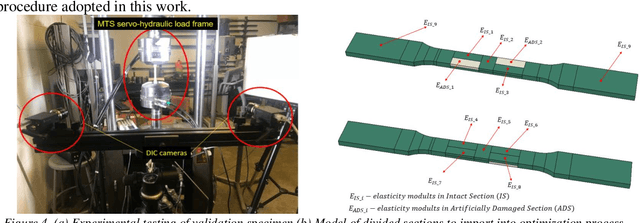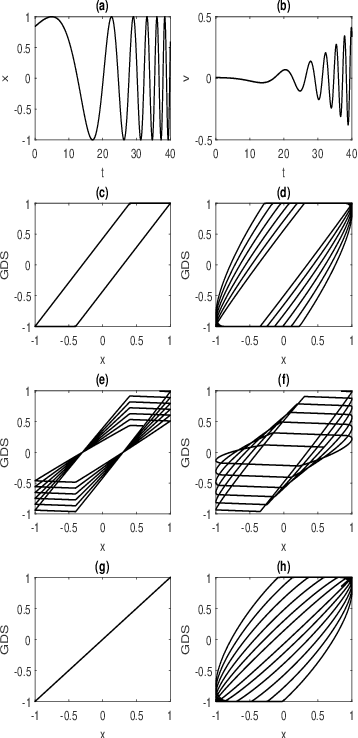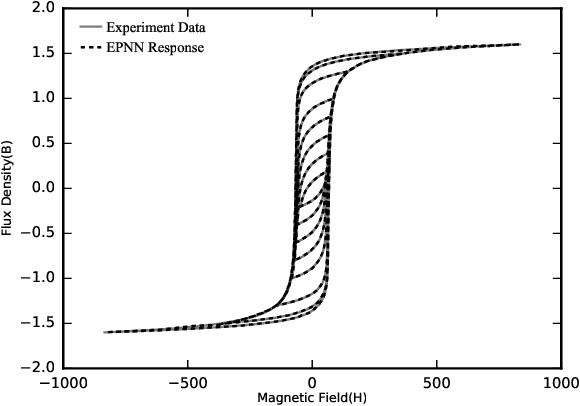Mehrdad Shafiei Dizaji
Deep learning-based Visual Measurement Extraction within an Adaptive Digital Twin Framework from Limited Data Using Transfer Learning
Oct 07, 2024Abstract:Digital Twins technology is revolutionizing decision-making in scientific research by integrating models and simulations with real-time data. Unlike traditional Structural Health Monitoring methods, which rely on computationally intensive Digital Image Correlation and have limitations in real-time data integration, this research proposes a novel approach using Artificial Intelligence. Specifically, Convolutional Neural Networks are employed to analyze structural behaviors in real-time by correlating Digital Image Correlation speckle pattern images with deformation fields. Initially focusing on two-dimensional speckle patterns, the research extends to three-dimensional applications using stereo-paired images for comprehensive deformation analysis. This method overcomes computational challenges by utilizing a mix of synthetically generated and authentic speckle pattern images for training the Convolutional Neural Networks. The models are designed to be robust and versatile, offering a promising alternative to traditional measurement techniques and paving the way for advanced applications in three-dimensional modeling. This advancement signifies a shift towards more efficient and dynamic structural health monitoring by leveraging the power of Artificial Intelligence for real-time simulation and analysis.
A Hybrid Training Algorithm for Continuum Deep Learning Neuro-Skin Neural Network
Feb 03, 2023Abstract:In this brief paper, a learning algorithm is developed for Deep Learning NeuroSkin Neural Network to improve their learning properties. Neuroskin is a new type of neural network presented recently by the authors. It is comprised of a cellular membrane which has a neuron attached to each cell. The neuron is the cells nucleus. A neuroskin is modelled using finite elements. Each element of the finite element represents a cell. Each cells neuron has dendritic fibers which connects it to the nodes of the cell. On the other hand, its axon is connected to the nodes of a number of different neurons. The neuroskin is trained to contract upon receiving an input. The learning takes place during updating iterations using sensitivity analysis. It is shown that while the neuroskin cannot present the desirable response, it improves gradually to the desired level.
Computer Vision based Tomography of Structures Using 3D Digital Image Correlation
Dec 18, 2020



Abstract:Internal properties of a sample can be observed by medical imaging tools, such as ultrasound devices, magnetic resonance imaging (MRI) and optical coherence tomography (OCT) which are based on relying on changes in material density or chemical composition [1-21]. As a preliminary investigation, the feasibility to detect interior defects inferred from the discrepancy in elasticity modulus distribution of a three-dimensional heterogeneous sample using only surface full-field measurements and finite element model updating as an inverse optimization algorithm without any assumption about local homogeneities and also the elasticity modulus distribution is investigated. Recently, the authors took advantages of the digital image correlation technique as a full field measurement in constitutive property identification of a full-scale steel component [22-27]. To the extension of previous works, in this brief technical note, the new idea intended at recovering unseen volumetric defect distributions within the interior of three-dimensional heterogeneous space of the structural component using 3D-Digital Image Correlation for structural identification [28-57]. As a proof of concept, the results of this paper illustrate the potential to identify invisible internal defect by the proposed computer vision technique establishes the potential for new opportunities to characterize internal heterogeneous materials for their mechanical property distribution and condition state.
Training of Deep Learning Neuro-Skin Neural Network
Jul 03, 2020


Abstract:In this brief paper, a learning algorithm is developed for Deep Learning Neuro-Skin Neural Network to improve their learning properties. Neuroskin is a new type of neural network presented recently by the authors. It is comprised of a cellular membrane which has a neuron attached to each cell. The neuron is the cells nucleus. A neuroskin is modelled using finite elements. Each element of the finite element represents a cell. Each cells neuron has dendritic fibers which connects it to the nodes of the cell. On the other hand, its axon is connected to the nodes of a number of different neurons. The neuroskin is trained to contract upon receiving an input. The learning takes place during updating iterations using sensitivity analysis. It is shown that while the neuroskin can not present the desirable response, it improves gradually to the desired level.
Universal Hysteresis Identification Using Extended Preisach Neural Network
Dec 22, 2019



Abstract:Hysteresis phenomena have been observed in different branches of physics and engineering sciences. Therefore, several models have been proposed for hysteresis simulation in different fields; however, almost neither of them can be utilized universally. In this paper by inspiring of Preisach Neural Network which was inspired by the Preisach model that basically stemmed from Madelungs rules and using the learning capability of the neural networks, an adaptive universal model for hysteresis is introduced and called Extended Preisach Neural Network Model. It is comprised of input, output and, two hidden layers. The input and output layers contain linear neurons while the first hidden layer incorporates neurons called Deteriorating Stop neurons, which their activation function follows Deteriorating Stop operator. Deteriorating Stop operators can generate non-congruent hysteresis loops. The second hidden layer includes Sigmoidal neurons. Adding the second hidden layer, helps the neural network learn non-Masing and asymmetric hysteresis loops very smoothly. At the input layer, besides input data the rate at which input data changes, is included as well in order to give the model the capability of learning rate-dependent hysteresis loops. Hence, the proposed approach has the capability of the simulation of both rate-independent and rate-dependent hysteresis with either congruent or non-congruent loops as well as symmetric and asymmetric loops. A new hybridized algorithm has been adopted for training the model which is based on a combination of the Genetic Algorithm and the optimization method of sub-gradient with space dilatation. The generality of the proposed model has been evaluated by applying it to various hysteresis from different areas of engineering with different characteristics. The results show that the model is successful in the identification of the considered hystereses.
 Add to Chrome
Add to Chrome Add to Firefox
Add to Firefox Add to Edge
Add to Edge